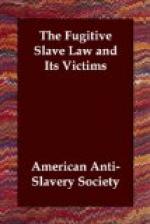men, named Merrill and Russell, were arrested and tried
as his kidnappers, and the fact fully proven.
But the case was got into the United States Courts,
and the criminals went unpunished. [end of note]
Nine slaves left their masters in Boone County, Kentucky, on Sunday, June 11, 1854, having three horses with them. Arrived at the river, they turned the horses back, and taking a skiff crossed at midnight to the Ohio shore. After travelling two or three miles, they hid during Monday in a clump of bushes. At night they started northward again. A man, named John Gyser, met them and promised to assist them. He took them to a stable, where they were to remain until night. He immediately went to Covington, Kentucky, learned that $1,000 reward was offered for their apprehension, and gave information of their place of concealment. At evening a strong band of Kentuckians, with United States Deputy Marshal George Thayer, assisted by three Cincinnati officers, surrounded the stable and took the nine prisoners, on a warrant issued by United States Commissioner Pendery. They were all given up to their claimants, and taken back to Kentucky.
A New Orleans correspondent of the New York Tribune, in a letter dated July 3, 1854, writes, “During a recent trip up the river I was on several steamers, and on every boat they had one or more runaway slaves, who had been caught and were being taken in irons to their masters.”
On the Steamer Alvin Adams, at Madison, Indiana, a man was arrested as a fugitive and taken to Louisville, Kentucky. He was claimed as the slave of John H. Page, of Bowling Green. The Louisville Journal, edited by a Northern man, stigmatised him as a “rascal,” for his attempt to be free. (July, 1854.)
Two colored men, on their way to Chicago, were seized and taken from the cars at Lasalle, Illinois, by three men, who said they were not officers. The colored men were known to be free; one was “a respectable resident of Chicago.” Some of the passengers interfered; but it being night, and very dark, and the cars starting on the colored men were left in the hands of their kidnappers.
Chicago, Illinois. Three men from Missouri, with a warrant from the Governor of that State, to take a certain fugitive slave, seized a man whom they met in the street, bound him with a handkerchief, and to quicken his steps beat him with the butt of a pistol. He succeeded in shaking off his captors and fled, a pistol-bullet being sent after him, which did not hit him. He made good his escape. The men were arrested and held to trial for assault with deadly weapons. By an extraordinary conspiracy on the part of District Attorney Hoyne, Sheriff Bradley, and others, these men were taken from jail to be carried to Springfield, Illinois, two hundred miles distant, to appear before Chief Justice Treat, that




